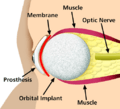Biomedical engineering facts for kids
Biomedical engineering is the study of medical equipment used in an environment of care or training and how this equipment interfaces with the human body.

Biomedical engineers design, test, modify, recommend modification of, and evaluate all medical equipment used to interface or interact with the human body. In addition to these functions, clinical engineers usually supervise the biomedical equipment maintenance function within an environment of care.
The medical devices include man-made hands, arms, and legs to replace lost ones and, also, Dialysis machines which clean the blood of a person with damaged kidneys.
Images for kids
-
Hemodialysis, a process of purifying the blood of a person whose kidneys are not working normally.
-
A ribosome is a biological machine that utilizes protein dynamics
-
Artificial limbs: The right arm is an example of a prosthesis, and the left arm is an example of myoelectric control.
-
A prosthetic eye, an example of a biomedical engineering application of mechanical engineering and biocompatible materials to ophthalmology.
-
Ultrasound representation of urinary bladder (black butterfly-like shape) a hyperplastic prostate. An example of practical science and medical science working together.
-
Implants, such as artificial hip joints, are generally extensively regulated due to the invasive nature of such devices.
See also
 In Spanish: Ingeniería biomédica para niños
In Spanish: Ingeniería biomédica para niños










